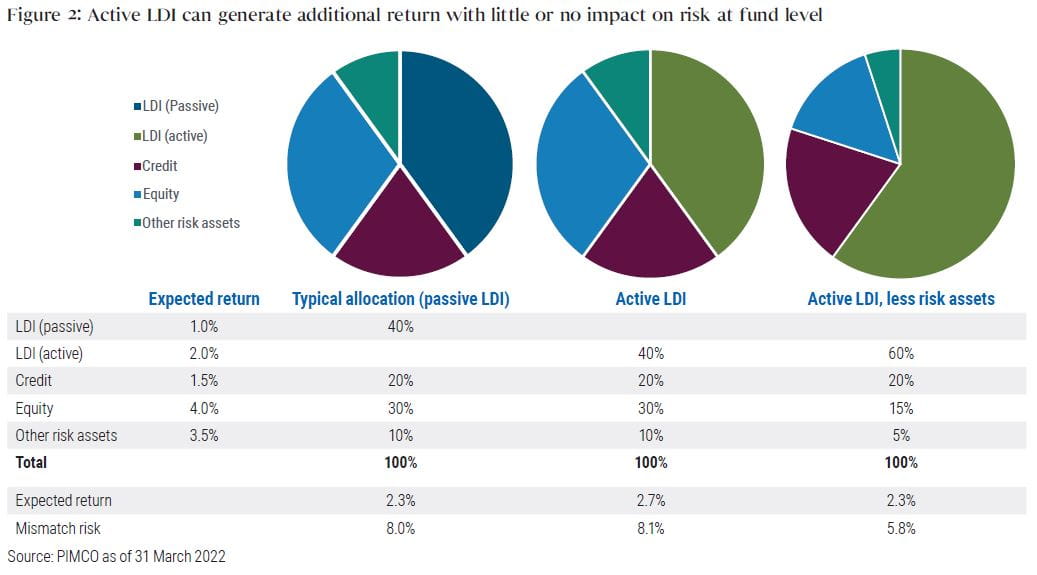
Despite recent increases in interest rates, pension funds seeking to hedge liabilities with passive exposures to long-dated bonds and swaps are still locking in negative real returns. In our view, however, it’s possible to systematically add alpha to liability-driven investing (LDI) portfolios with little additional risk. Active management holds the key.
Pension funds have a liability-matching dilemma: They invest a large part of their assets in long-dated bonds and swaps to hedge liabilities. But nominal yields on these investments are near historical lows of around 1%. Even after recent increases in interest rates, real yields on these instruments remain deeply negative. Thus, a passive allocation to these instruments means locking in a negative real return – for decades – on a large part of a pension fund’s portfolio.
Active management can achieve better results, in our view. PIMCO’s active LDI mandates have outperformed passive approaches by 0.5–1.5 percentage points per year over the past 10-plus years. Amid today’s low rates, accumulating this additional return could make a substantial difference over time.
Yet many may ask: Can active LDI systematically generate additional returns? Doesn’t that add risk to the (matching) part of our portfolio that is intended to reduce risk? And doesn’t active management belong in the return – and not in the matching – portfolio?
Our experience shows that it is indeed possible to systematically add alpha in LDI and other fixed income portfolios; and that active LDI adds little to no additional risk to the matching portfolio. It even makes it possible to reduce asset-liability risks. What’s more, active fixed income management has unique potential to add value to LDI portfolios in a way that cannot be implemented in return portfolios. Active LDI therefore cannot be replaced by investing more actively in the return portfolio.
Is it possible to add value to a matching portfolio systematically?
Yes. Our experience shows that it is possible to systematically earn additional return on a matching portfolio. A number of structural factors make this possible.
First, the global bond market is much larger in size than the global equity market. As a result, it offers a far greater opportunity set for active managers – for instance, relative value opportunities among similar issuers, sectors, or securities. In addition, a large share of bond market activity is conducted by participants whose primary objective is not strictly the maximization of profit. Global central banks, for instance, often make large, price- insensitive asset purchases in specific sectors of the bond market. Insurance companies also buy bonds for regulatory purposes rather than profit maximization. As a result, these actors can create persistent market inefficiencies and dislocations that active bond managers can exploit. This is why active fixed income managers have historically outperformed their benchmarks. It also explains why active equity managers have, on average, been unable to beat the market.
Digging deeper, consider inefficiencies in the pricing of European government bonds, which are often cheaper in the futures market than in the physical market. This results chiefly because of the European Central Bank’s asset-purchase programs, which have removed a large amount of government bonds from the market. Put simply, this scarcity incentivizes investors to purchase longer-dated government bonds in the future and not today.
In our estimation, active managers can take advantage of this bond market inefficiency and achieve up to 50 basis points of additional return annually by substituting physical bonds with bond futures. Investors get the same position and the same risk, but with higher return potential.
Other sources of alpha potential include inefficiencies around new bond issuance. New bonds come to market much more frequently than new shares do. And this creates market dislocations due to monthly rebalancing of bond market benchmarks.
Figures 1a and 1b summarise the track record of our EUR LDI composite. The left-hand graph shows that average alpha of about 1.4% per year has accumulated to a total outperformance of 65 percentage points since 2004 (206.6% cumulative return of the composite versus 141.9% for the liability benchmark). Figure 1b shows we achieved this while still closely matching liabilities: The correlation between composite and benchmark performance was over 98%.

Does active LDI add risk to the (matching) part of the portfolio that is meant to reduce risk?
No. The primary purpose of active LDI portfolios is to hedge liabilities. Interest rate risk is therefore always the dominant risk position in our mandates; portfolio duration will never deviate much from those of the liabilities. The correlation between the matching portfolio and liabilities is therefore very high, often 98% or 99%. But, in addition, it is possible to generate additional returns with a wide range of relatively small, diversified positions. This approach means that the correlation between our LDI alpha and the rest of the portfolio is low, so returns on the matching portfolio can be increased with little or no impact on risk at the overall pension fund level. It even makes it possible to reduce asset-liability risks by investing more in matching and less in the return portfolio, without sacrificing returns (see Figure 2).

Note, this data assumes a typical pension fund portfolio and a target hedge ratio of 60% of liabilities. We estimate funding level volatility to be 8.0%, assuming a passive LDI portfolio. If we replace the passive portfolio with our LDI track record, total funding level volatility increases marginally to 8.1%. However, the expected return will increase by 0.4 percentage points, assuming a matching allocation of 40% and 1% alpha. So more return for a marginal increase in risk.
Pension funds can use the higher return on the matching portfolio to invest less in the return portfolio. Figure 2 shows that by generating a windfall amid low credit spreads and high equity valuations, pension funds can shift 20% of their portfolio from return to matching, reducing risk from 8.0% to 5.8%, but still achieving the same return. It seems paradoxical, but active LDI management in this case means less risk.
Can’t the return portfolio generate the alpha?
No. Many alpha opportunities are unique to the LDI portfolio and the active positions cannot be taken in the return portfolio. In some cases this is technically impossible. For example, one could only replace government bonds with cheaper bond futures if there are government bonds in the portfolio to start with. Government bonds are often included in matching portfolios, but normally not in return portfolios. By deploying active risk more broadly, the risk/return profile of the total portfolio improves.
In other cases, the positions are only worthwhile in a matching context. For example, a covered bond provides a few tenths of a percentage point of extra yield compared to a government bond, for little additional risk. That’s worth it in a low-yielding matching portfolio. But of course it makes no sense to replace, for example, equities or corporate bonds with covered bonds in a return portfolio. That costs returns.
Finally
The strict division of pension portfolios into return and matching, whereby matching is purely focused on interest rate hedging, is not optimal in our opinion. There are many opportunities to add value to LDI portfolios without significantly changing risk at the fund level. Making the matching portfolio work harder creates a broader base of returns for the portfolio. This results in a more robust investment strategy and better opportunities to realize pension ambitions. Which pension fund does not want to go for that?

